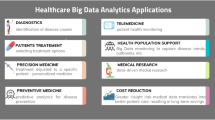Abstract
Day by day surveillance of hospital acquired infections is a time- consuming activity. Healthcare professionals need powerful computer tools to manage and analyse these data. Such a program must include all the functions needed to manage communication with other programs in order to minimise data entry. Coherence checks are then used to validate data. Automatic production of reports, graphics or tables enables users to quickly obtain timely and representative documents regarding the evolution of specific indicators. The local person in charge for the system must be able to easily modify many parts of the program (data entry screens, calculations, checks, etc.) without any direct intervention from a computer specialist. Using this description, we have created a specific software for the management of this information named NosoCom. The program has been used for four years in France and Belgium. An English release is now available.
Similar content being viewed by others
References
Hospital Infection Center, National Center for infectious disease. CDC Public health focus: Surveillance, prevention, and control of nosocomial infections. MMWR. 1992; 41: 783–787.
Haley RW, Culver DH, White JW, Morgan WM, Emori TG. The nation wide nosocomial infection rate: A new need for vital statistics. Am J Epidemiol 1985; 121: 159–167.
Haley RW, Culver DH, White JW, Morgan WM, Emori TG, MUNN VP, Hooton T. The efficacy of infection surveillance and control programs in preventing nosocomial infections in US hospitals. Am J Epidemiol 1985; 121: 182–205.
Avril JL, Donio PY. La surveillance des infections nosocomiales. Rev Prat 1989; 39(16): 1381–1385.
Brewer JH, Gasser CS. The affinity between continuous quality improvement and epidemic surveillance. Infect Control and Hosp Epidemiol 1993; 14(2): 95–97.
Brachman PS. Nosocomial infections surveillance. Infect Control and Hosp Epidemiol 1993; 14: 194–196.
Gaunt PN. Information in infection control. J Hosp Infect 1991; 18(Suppl A): 397–401.
Dessau RB, Steenberg P. Computerized surveillance in clinical microbiology with time series analysis. J Clin Microbiol 1993; 31(4): 857–860.
Legras B, Patris A, Legras J, Burdin JC, Feldmann F, Weber M, Blech MF, Hartemann Ph. Une aide automatisée á la détection des infections nosocomiales á partir d'un fichier central de bactériologie. Med Mal Infect 1989; 19(12): 728–733.
Talon D, Vincent C, Lionnet JM, Viel JF, Lab M, Michel-Briand Y. Infections nosocomiales: Détection continue des épidémies et alerte par réseau informatique. Med Mal Infect 1992; 22: 935–936.
LaHaise S. A comparaison of infection control software for use by hospital epidemiologists in meeting the new JACO standards. Infect Control and Hosp Epidemiol, 1990; 11(4): 185–190.
Mertens R. Un logiciel PC pour la surveillance locale et l'analyse multicentres des infections hospitaliéres. Hygiénes 1993; 2: 21–23.
Evans RS, Larsen AL, Burke JP, Gardner RM, Meier FA, Jacobson JA, Conti AT, Jacobson JT, Husle RK. Computer surveillance of hospital-acquired infections and antibiotic use. JAMA 1986; 256: 1007–1011.
Collen MF, Ball MJ. Technologies for computer-based patient records. Proceedings of the seventh world congress on medical informatics, Geneva, 1992.
Emori G, Culver DH, Horan TC, Jarvis WR, White JJ, Olson DR, Banerjee S, Edwards JR, Martone JW, Gaynes RP, Hughes JM. National nosocomial infection surveillance system (NNIS): Description of surveillance methods. Am J Infect Control 1991; 19(1): 19–35.
Bhattacharyya N, Kosloske AM, Macarthur. Nosocomial infection in pediatric surgical patients: A study of 608 infants and children. J Pediatr Surg 1993; 28(3): 338–344.
Bowen-Jones A, Wesley J, Van Den Ende. Nosocomial colonisation and infection in a paediatric respiratory intensive care unit. S Afr Med J 1992; 82: 309–313.
Bronsema DA, Adams JR, Pallares R, Wenzel RP. Secular trends in rates and etiology of nosocomial urinary tract infections at a university hospital. J Urol 1993; 150: 414–416.
Horan TC, Culver DH, Gaynes RP, Jarvis WR, Edwards JR, Reid CR. Nosocomial infections in surgical patients in the United States, January 1986–June 1992. Infect Control Hosp Epidemiol 1993; 14(2): 73–80.
Desvé G, Cauët D, Dromer F. L'outil informatique au service de la surveillance. La lettre de l'infectiologue 1993; 8(11): 376–377.
Cauët D, Quenon JL, Desvé G. Un outil pour l'informatisation des enquêtes de prévalence des infections nosocomiales. HygiéneS 1998; VI(1): 47–50.
Author information
Authors and Affiliations
Rights and permissions
About this article
Cite this article
Cauët, D., Quenon, J. & Desvé, G. Surveillance of hospital acquired infections: Presentation of acomputerised system. Eur J Epidemiol 15, 149–153 (1999). https://doi.org/10.1023/A:1007508432721
Issue Date:
DOI: https://doi.org/10.1023/A:1007508432721




